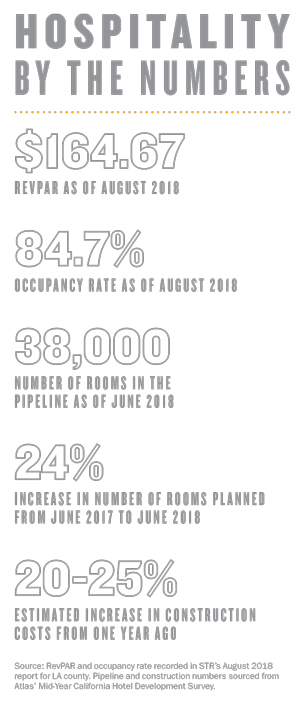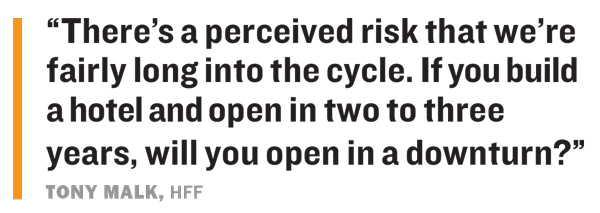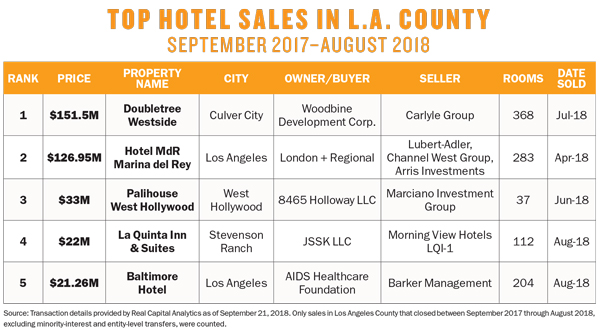The Los Angeles hotel building boom has been hot for so long that some observers are anticipating a cooldown.
L.A. County RevPAR (revenue per available room) hit an all-time high of $164.67 while maintaining 84.7 percent occupancy in August, according to data from STR.
And there is still plenty of room for new hotels, according to experts tracking the market. New rooms made up less than 3 percent of the overall supply both this year and last, according to Bruce Baltin, managing director of CBRE Hotels Consulting.
But Tony Malk, managing director at commercial real estate advisory firm HFF, said that as construction prices rise, he expects fewer ground-up projects and more acquisitions, such as the nearly $127 million deal he brokered in April for the 283-room Hotel MdR, a Doubletree by Hilton Hotel in Marina del Rey. The sale was the second-priciest hotel trade in L.A. County from July 2017 to August 2018, according to data from Real Capital Analytics.
“There’s a perceived risk that we’re fairly long into the cycle,” said Malk. “If you build a hotel and open in two to three years, will you open in a downturn?”
Baltin said he expects growth of hotel room supply in L.A. to decrease to 2.7 percent next year from the 3.1 percent this year.
“I think it will keep going down,” said Baltin. “We’ve seen the peak of the building.”
But for the moment, there’s still a large number of projects in the pipeline, said Alan Reay, president of Irvine hotel brokerage Atlas Hospitality Group. “We’re seeing record profits at hotels,” he said.
 The county had almost 38,000 rooms at 246 hotels in the planning stage as of June — that’s an increase of 24 percent more rooms in planning than during the same period last year, according to Atlas’ Mid-Year California Hotel Development Survey.
The county had almost 38,000 rooms at 246 hotels in the planning stage as of June — that’s an increase of 24 percent more rooms in planning than during the same period last year, according to Atlas’ Mid-Year California Hotel Development Survey.
Below, TRD looks into the deals behind the priciest hotel trades over the last 12 months.
Selling the Doubletree Westside
While investors have long coveted hotels on the Westside due to their proximity to the Pacific Ocean, the area’s popularity with tech companies has made such properties even more attractive. The largest hotel transaction of the last 12 months was the 368-room Doubletree Westside, a full-service hotel in Culver City. Dallas-based real estate investment firm Woodbine Development Corporation paid $151.5 million for the property and an adjacent parking lot zoned for office space.
Woodbine had been in talks with global alternative asset manager Carlyle Group to acquire the property a few years ago, but the deal fell apart because of entitlement issues, according to Dupree Scovell, Woodbine managing partner and chief investment officer. So when Carlyle, which has $210 billion in assets under management, resolved the issues, Woodbine made an offer before it could even market the property, Scovell said.
Despite the hotel selling for more than four times the $33.3 million Carlyle paid for it in 2006, CBRE’s Baltin said the price was reasonable given the market.
“That hotel used to have a lower-rated airline business,” said Baltin, adding that airline crews are generally given reduced rates. “I’m sure it’s doing much better being so close to Silicon Beach.”
Indeed, the hotel’s location, which once could have been seen as less than ideal due to its close proximity to the 405 freeway and being farther than some airport hotels from LAX, has become its greatest asset, Scovell said.
“The way I describe it, even five years ago, this was still in effect a not greatly located airport hotel,” said Scovell. “Then you got Yahoo, YouTube, Google, Facebook, Belkin — all these groups started to occupy Playa Vista. It doesn’t take a lot of imagination to see where the market is going.”
Scovell also noted the proximity of the hotel — which has 20,000 square feet of meeting space, according to Real Capital Analytics — to the planned stadium in Inglewood and the Culver City office locations of Apple, Beats and Amazon.
Woodbine plans to spend $30 to $40 million to significantly upgrade the hotel, including adding a restaurant and completely redoing the rooms and landscaping, Scovell said. He added that the firm planned to work with Hilton to pick a more upscale brand.

“From top to bottom, we’re going to kind of reinvent that product,” he said.
And despite construction costs, which Atlas Hospitality Group estimates have increased 20 to 25 percent since last year, Scovell said that Woodbine, which specializes in building from the ground up, is still bullish on Los Angeles. The firm constructed the 175-room AC Hotel Irvine in Orange County last year.
Inside the sale of Hotel MdR
HFF’s Malk knew that the owners of the full-service Hotel MdR wanted to sell after buying the property in 2013 for $52.5 million and renovating it the following year.
So when international investors London + Regional were looking for their first hotel in Los Angeles, he
took them to see the property even though it wasn’t on the market.
“A lot of international investors really like L.A.,” said Malk. “Hotel trades seem more scarce here than in other markets. There are a lot of long-term owners, so when a hotel is in a good location, it gets a lot of interest.”
Malk said that the Hotel MdR had already enjoyed an increase in business since the renovation, and that he only expected it to get better with the continued growth of Silicon Beach, including Google’s move into the Spruce Goose hangar in Playa Vista a few miles away.
Although a dual-branded Courtyard Marriott and Residence Inn is under construction on the other side of the Marina, Malk said that there was little competitive new supply expected to come on the market.
“It has seen a nice ramp-up, but clearly there’s more room with the renovation and the growth in the submarket,” he said.
London + Regional, which has hotels around the world, made an offer close to what the owners, which included real estate investment firms Lubert-Adler, Channel West Group and Arris Investments, wanted, according to Malk. The final transaction price of $127 million was more than double what the prior owners had paid for it.

The U.K. investment firm hasn’t yet decided what changes it will make to the property, although Malk noted that the rooms hadn’t been included in the last renovation. HFF helped secure a five-year floating-rate loan with a Germany-based lender.
How the Palihouse Hollway hotel was sold
The Palihouse West Hollywood, which sold for $33 million in the third-largest transaction of the year, is representative of the type of boutique hotels that have become popular in West Hollywood.
“It’s the nature of the business around West Hollywood,” said Reay. “Millennials, film- and music-type clients go for the entertainment value. There’s no strong demand for business hotels [like] Marriott and Hilton.”
Although the overall deal size was significantly less than the two largest transactions, the Palihouse West Hollywood fetched the highest price per room by far, at $892,000. The property has 37 studio, one- and two-bedroom guest suites and loft-style residences, all of which have kitchens, according to its website.
CBRE’s Baltin said that the large size of the rooms and the strength of the hotel’s food and beverage program, which includes Mardi Restaurant, meant that the buyer, a limited liability corporation, didn’t overpay.
The hotel’s operator, Paligroup, has a second West Hollywood hotel, Palihouse Melrose, as well as a location in Santa Monica. According to its website, it has plans for locations in Westwood Village, Culver City and a handful of other locations around the country. Paligroup didn’t respond to repeated requests for comment.
Rising wages and increasing construction costs have dictated the types of projects getting built, experts say. That includes luxury boutique hotels, which Baltin says tend to be more profitable than more modestly priced counterparts, as well as limited-service options like Courtyard Marriott, which require less staff.
Limited-service hotels are mostly being built in the outlying areas of Los Angeles County, like the 112-unit La Quinta Inn & Suites in the Santa Clarita Valley, said Reay from Atlas, which helped broker its $22 million sale in August.
“The economy here is hitting all cylinders,” said Reay. “The good news is that it’s doing well. The bad news is that finding employees at reasonable pay rates is becoming much more difficult for hotel owners.”
The heat Downtown
In addition to the Westside and West Hollywood, Downtown continues to draw interest from investors. Los Angeles leads the state in number of rooms constructed or under construction, and the majority of those are Downtown, Atlas’ Reay said.
Tax breaks from the city have allowed developers to keep building full-service hotels Downtown, in spite of a tightening labor market and increased cost for materials, Reay said. And rather than dampening the market, the new rooms have fanned the flames by attracting more conventions, he added.
“A lot of existing hotels that were not given a break felt at a competitive disadvantage,” said Reay. “Usually when you add a lot more rooms, you see RevPAR decline.”
The fact that RevPAR has increased shows the continued demand Downtown, he said.
Mike Condon Jr. , an executive managing director at Cushman & Wakefield, said he thinks developers have just scratched the surface of the county’s potential number of hotels.
“Downtown L.A. is one of the most underexploited markets in the U.S. for the risk-return,” he said. “In a city of 20 million with media, tech, entertainment and some of the biggest influencers here, it just makes sense to be here.”
